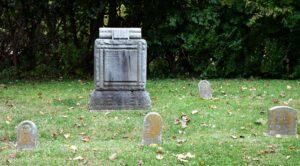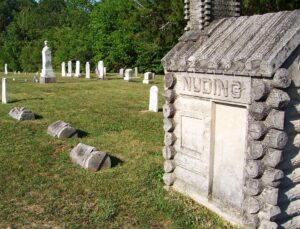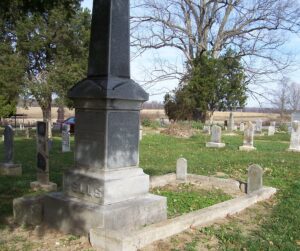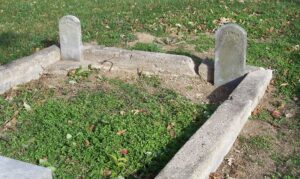We are all familiar with tombstones, the permanent memorials that mark the final resting places of our loved ones. Sometimes called headstones, these grave markers have been used to mark burial sites as far back as 3000 B.C. and are positioned at the head of the grave. These markers can be upright or flush with the ground and often provide a vast amount of information about the deceased.
What we don’t see as often in cemeteries in this part of the country are footstones. Footstones are set at the foot of a grave and are less about identity and more about boundary. They were used more frequently a few decades ago.
Set at the opposite end from the headstone, footstones serve to mark the boundary of the burial plot. Like headstones, footstones may be upright or flush with the grass.

Headstone and footstone at burial site. Pingry Cemetery
Footstones are usually less ornate and are smaller than the headstone. Most are about 1-2 feet wide. They may be engraved with text or images. Since a headstone includes most of the standard information about the person (name, birth date and death date, a quote and some funerary art), the smaller footstone usually features only the person’s initials. They are smaller and less ornate so they do not distract from the headstone.

Footstone, Pingry Cemetery
The headstone marks the upper boundary of the grave site and the footstone marks the lower boundary, helping visitors to avoid walking across the grave, which is sometimes deemed disrespectful or bad luck. In addition, footstones clearly distinguish one gravesite from another for cemetery workers.
Sometimes there is no headstone and a footstone is the only grave marker. In that case the footstone still sits at the foot-end of the grave, but the footstone might be slightly larger so that it can incorporate some of the information that is usually on the headstone. Solitary footstones for individual graves are a more common in modern cemeteries, where site owners are trying to conserve space.
Some cemeteries have family burial plots, consisting of a large upright headstone with the family name, and smaller stones with individual names surrounding the large family stone. These small stones are also considered footstones. Each member of the family has their own footstone near the family headstone.

Family burial plot with footstones around the central headstone. Elm Grove Cemetery, St. Marys, Ohio

Family burial plot, with footstones around central marker.

Family burial plot, with footstones near central marker.

Family burial plot with footstones Mother and Father. Liber Cemetery.

Closer look of family burial plot with footstones Mother and Father. Liber Cemetery.
Some cemeteries limit the number of upright headstones and require that footstones be used instead of headstones.

